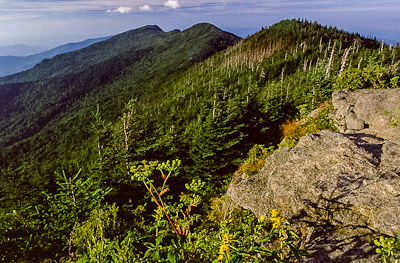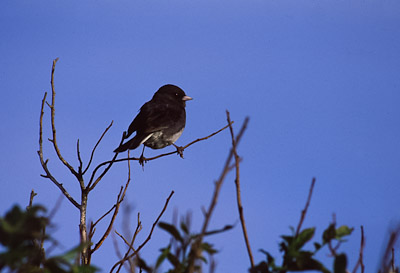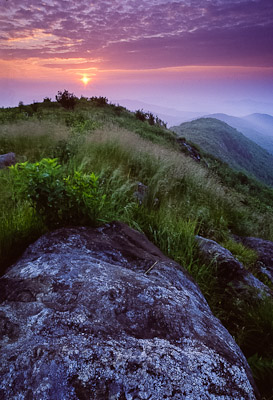Beyond 6,000: The South's Highest Peaks
[originally published as "40x6,000," March/April 2011 Blue Ridge Country]
When the Sierra Club was a small California outings group, they had a saying: “Life begins at 10,000 feet!” That enthusiasm for the High Sierra zone of bare granite, glacial lakes, and simplified biology is easily adapted to the southern Appalachians, which have their own unique high-elevation appeal. Here, “life begins at 6,000 feet!,” where summer clouds waft through Fraser fir forests, rime ice covers exposed balds, and northern animals stake out a tenuous existence hundreds of miles south of their usual ranges.
I have always been drawn to these isolated ecosystems, which occupy only about 70,000 total acres in a few scattered locations south of Roanoke. North of there, the Appalachian Extension of boreal habitat appears again in West Virginia, but with Balsam firs instead of Frasers. In the South, points above 6,000 feet hold what is truly one of our rarest and most endangered ecosystems, with the well-publicized problems of exotic insect pests, acid deposition from air pollution, and climate change threatening their long-term existence.
It is this rare appeal, coupled with the natural human tendency to climb things, that gave birth to a challenge program recognizing anyone who has ascended all forty official “Southern Sixers” and encouraging others to do so. Now known as South Beyond 6000, or SB6K, this joint project of the Carolina Mountain Club (CMC) and the Tennessee Eastman Hiking and Canoeing Club (TEHCC) not only celebrates our high points but also introduces hikers to off-trail exploration and the six distinct ranges that encompass the peaks: the Blacks, Craggies, Great Balsams, and Plott Balsams in North Carolina, and the Smokies and Roans on the North Carolina/Tennessee border.
 |
The Black Mountain crest from Mt. Craig (6,647'). |
I first learned of the program in the mid-nineties, after I’d spent years hiking western North Carolina’s high country. When I saw the list of high points, I recognized many names and figured I’d climbed more than half of them. Then I saw the criteria for an ‘official ascent:’ climb at least 500 feet and hike at least five miles. Popping up to the top of Waterrock Knob from the Parkway lot 0.6-mile away wasn’t good enough, and neither were my short hikes to Clingman’s Dome, Richland Balsam, Mt. Hallback, and Mt. Hardy.
It was therefore fifteen years before I finished the forty peaks. Though most share a common ecosystem, their diversity is remarkable. Climbing Craggy Dome from the valley on a late fall day provided incredible solitude as I crossed the closed Parkway through silent beech forests into the rhododendron heath. I have returned again and again to the open balds and quartz outcrops that characterize Sam Knob and Shining Rock in the Great Balsam range. On the other hand, struggling half-blind through blackberry cane after losing a contact lens on Mark’s Knob in the eastern Smokies gave me no desire to ever go there again. But even that trip, remembered in its entirety – three backcountry days of bushwhacking eight remote peaks along a 40-mile circuit of trail – filled me with satisfaction as I dunked my sweaty head into Big Creek at the end of it. Of course, the most satisfaction came on an evening in May 2009 when I finished my last summit, Mt. LeConte, just before rushing to a nearby promontory to photograph sand myrtle blooming among the rocks at sunset.
 |
Sunset on Myrtle Point, Mt. LeConte (6,593'), Great Smokies. |
What makes a mountain one of the forty official Southern Sixers? Not just altitude – there are actually over 100 peaks, subpeaks, and bumps on ridges that break the 6,000-foot mark in the southern Appalachians. Technically, a qualifying Sixer should 1) have at least 200 feet of prominence (elevation above any contour it shares with a higher peak), or 2) be at least 3/4-mile away from any neighboring Sixer, and have at least 120 feet of prominence.
“It’s somewhat of a historic list,” says Peter Barr, current chair of the CMC’s SB6K committee. I talked with Barr on the porch of a hostel along Tennessee’s Nolichucky River during his thru-hike of the Appalachian Trail. He explained that the requirements were based on a similar program in the Adirondacks, but are not always perfect. The list includes the Black Mountains’ Potato Hill, for example, but omits Cattail Peak, because Cattail is just enough closer to Balsam Cone to be eliminated despite being 125 feet taller than Potato. One Smokies summit, LeConte’s subpeak of West Point, meets the technical requirements but is excluded because the LeConte massif historically has been considered a single mountain. (Contrary to a recent article in Blue Ridge Outdoors that claimed ‘dozens’ of qualifying peaks are not included, West Point is the only true qualifier left out.) Boreal enthusiasts may also be disappointed that many famous fir-adorned peaks don’t quite make the 6,000-foot mark. North Carolina’s Grandfather Mountain falls just short at 5,946 feet, and Virginia’s Mount Rogers comes in at 5,729 feet.
However, the point of SB6K was never to obsess over statistics. (If the U.S. ever adopts the metric system, future generations will find the whole “6,000” concept arbitrary and anachronistic anyway.) The lines are drawn, and, since the program’s beginnings in 1968, only 190 people have completed it – a fraction of those finishing similar programs in the Adirondacks and New England. The achievement still has an exclusive appeal, and perhaps that is part of the reason that participation has ballooned since the 1990s, making the program the CMC’s most popular challenge, with an average of five new finishers each year.
Unfortunately, SB6K records consist of only names and completion dates, so it’s impossible to know for sure who climbed all the peaks first, who was the oldest completer, or what the average finisher looks like. Peter Barr, however, notes that the program attracts all ages (Jon Byrd was the youngest, finishing in 1985 at age 13) and is popular with father/son teams. A third of the completers are women. Eleven married couples have finished, and one man proposed to his now-wife on their final summit. Another couple, having met while working on SB6K, spent their honeymoon climbing some of the toughest peaks. There is no time limit, so while many hikers finish in a few years, others spend a lifetime casually working toward the goal.
 |
Junco, Roan Mountains. |
And some do it in 4 days, 14 hours, and 38 minutes. That is the current record, set in May 2010 by Matt Kirk of Marion, NC, for speed-climbing all forty peaks. The first speed-climb, nicknamed South Beyond Insanity, was pioneered by Ted Keizer, AKA Cave Dog, of Oregon in June 2003. The online account of his feat, which covered approximately 300 miles entirely on foot, is an epic tale of Cave Dog and his support team fighting relentless rain showers, overgrowth, darkness, and blisters for almost five days, proving that SB6K was worthy of national attention, at least among endurance athletes. In 2009, ultrarunners Jenny Anderson, Anne Lundblad, and Rebekah Trittipoe repeated the route in just over 6 ½ days, achieving their goal of finishing with a longer time as a trio rather than trying to set faster individual records.
Matt Kirk’s time beat Cave Dog’s by almost nine hours, but he is quick to point out that he experienced near-perfect weather and beat the worst of the summer overgrowth. Also, due to a misreading of Cave Dog’s account, he followed a section of Parkway at one point rather than Cave Dog’s harder route through briars and single-track. “It would therefore be extremely hard for me to claim a record,” he states on his website, though “the overall spirit of [the] challenge was upheld.”
Personally, I will never compete on the level of the South Beyond Insanity crowd, but I’ve done enough trail running and 20- to 30-mile dayhikes to understand a bit of what drives them. When I asked Kirk how he responds to critics who would label his achievement a stunt, or doubt his true appreciation for the landscapes he speeds through, he explained humbly and at length that his real goals have less to do with ego gratification than with private personal growth. “It’s a wonderful way to experience how magnificently rugged and unique these boreal peaks are…I can’t think of a better setting to break myself down and put myself back together again.” He acknowledged that many hikers get similar physical, mental, and spiritual rewards from less extreme outings, but he is not graced with that ability. For him (and many others), pushing personal limits is the only way “to deplete yourself so much – [you’re] breathing out the stress of civilization, taking in spruce-scented, fresh mountain air, and purifying yourself from the inside out.”
 |
Sunrise on Tennent Mountain (6,040'), Art Loeb Trail, Great Balsams. |
I had thought Mt. LeConte was the end of my peakbagging, but as I filled out my CMC ascent form, I began doubting my climb of one summit, Roan High Knob. Years ago I had spent a chilly December night in the two-story shelter near the top with friends, but I wasn’t sure we actually set foot on the summit. So I made another trip, dayhiking the A.T. from Hughes Gap up through blooming rhododendrons into the thick spruce-fir zone, where on Roan High Knob I found the summit rocks a stone’s throw from the shelter. Of course, I had been there before. The hike wasn’t necessary after all, but I ate lunch, poked around a bit, and headed back the way I came, confident that time above 6,000 feet is never wasted.
©Stephen Schoof